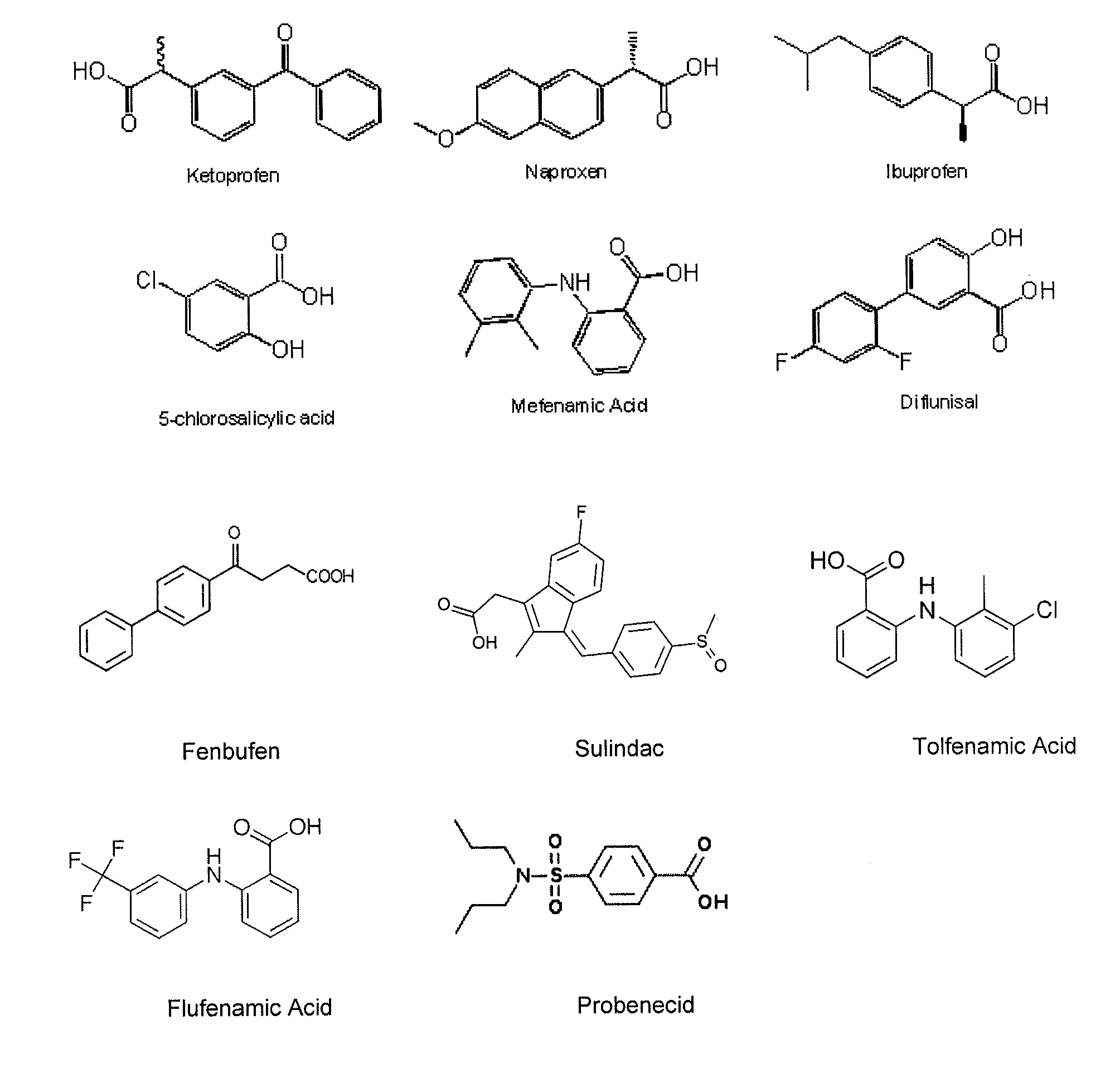Novel bismuth(III) nsaid compounds and methods for their use
- Summary
- Abstract
- Description
- Claims
- Application Information
AI Technical Summary
Benefits of technology
Problems solved by technology
Method used
Image
Examples
example 1
Reaction of Ketoprofen with BiPh3 (3:1)
[0104]The reaction of BiPh3 (1.0 mmol, 0.44 g) with ketoprofen (3.0 mmol, 0.77 g) was performed according to GP1. The reaction mixture was homogeneous. On completion of the reaction all volatiles were removed under reduced pressure. A crude solid, which precipitated on removal of the solvent, was taken up in chloroform (5 ml). Addition of hexane (5 ml) precipitated a white solid which was identified as bismuth(III) tris-{2-(3-benzoylphenyl)-propionoate} monohydrate, 1. Yield: 0.68 g, 70%. Melting point: 52-55° C. 1H NMR (200 MHz, d6-DMSO)δ=7.40 (27H, m, Ar), 3.86 (3H, q, J=7) 13C NMR (50 MHz, d6-DMSO) δ=194.8 (ArC═OAr) 136.1 (CH), 131.8 (Ar), 131.1 (CH), 128.7 (Ar), 127.7 (Ar), 11.9 (CH3). m / z (ESI+) 507 [L2H]+, 529 [L2Na]+, 761 [BiL2(EtOH)]+ (ESI−) 785 [BiL2Cl2]− (where L=C16H13OCO2−). νmax (cm−1) (KBr): 3300 b, 2727 w, 1706 w, 1655 m, 1596 w, 1576 w, 1348 m, 1283 m, 1178 w, 1075 m, 998 w, 953 w, 898 m, 835 m, 774 w, 719 m, 668 m, 667w. Anal. ...
example 2
Reaction of Naproxen with BiPh3 (3:1)
[0106]The reaction of BiPh3 (1.0 mmol, 0.44 g) with naproxen (3.0 mmol, 0.69 g) was performed and purified according to GP1 and GP2 producing a white solid in both cases. The solid was identified as bismuth(III) tris-{(S)-2-(6-methoxynaphthalen-2-yl)propanote}, 2. Yield: 0.72 g, 80%. Melting point: 193-194° C. 1H NMR (200 MHz, d6-DMSO) δ=7.13-7.70 (18H, m, Ar), 3.86 (9H, s, OCH3), 3.65 (3H, s, CHCH3), 1.40 (9H, s, CH3). 13C NMR (50 MHz, d6-DMSO) δ=156.5 (COCH3), 136.5 (Ar), 132.6 (Ar), 128.5 (Ar), 127.8 (Ar), 126.2 (Ar), 125.9 (Ar), 125.1 (Ar), 117.9 (Ar), 105.2 (Ar), 54.6 (OCH3), 18.3 (CH3). m / z (ESI+) 745.2 [BiL2(DMSO)]+, 823 [BiL2(DMSO)2]+; (ESI−) 229 [L]−, 459 [L2]− (where L=C13H13OCO2−). νmax (cm−1) (KBr): 3447 m, 2930 w, 1636 s, 1606 s, 1560 w, 1522 w, 1507 s, 1485 m, 1458 m, 1393 vs, 1273 vs, 1230 s, 1215 s, 1160 m, 1073 w, 1031 s, 928 w, 853 s, 809 m, 751 w, 713 m, 670 w, 473 s. Anal. found; C 56.1, H 4.4, Bi 22.9%; BiC42H39O9 requires C ...
example 3
Reaction of Ibuprofen with BiPh3 (3:1)
[0107]The reaction of BiPh3 (1.0 mmol, 0.44 g) with ibuprofen (3.0 mmol, 0.62 g) was performed according to GP1. On cooling to room temperature the final reaction mixture is a homogeneous toluene solution. All volatiles were removed under reduced pressure leaving a thick oily colourless liquid. Addition of methanol (10 ml) precipitated a white solid which was identified as bismuth(III) tris-{2-(4-isobutylphenyl)-propionoate}, 3.
[0108]Yield: 0.50 g, 60.6%. Melting point: 123-125° C. 1H NMR (300 MHz, d6-DMSO) δ=7.18 (6H, d, J=7.7 Hz, Ar), 7.05 (6H, d, J=7.7 Hz, Ar), 3.49 (3H, q, CH), 2.40 (6H, d, J=7.0 Hz, CH2), 1.80 (3H, m, CH2CH), 1.15 (18H, d, J=6.9 Hz, CH3), 0.84 (9H, d, J=6.6 Hz, CH3). 13C NMR (75 MHz, d6-DMSO) δ=170.6 (COOBi), 138.6 (CCH2), 128.1 (Ar), 126.7 (Ar), 43.7 (CH2), 29.0 (C(H)Me), 28.4 (CH(CH3)2), 21.6 (CH3), 18.4 (CH3). m / z (ESI+) 229 [LHNa]+, 847 [BiL3Na]+; (ESI−) 205 [L]−, 773 [BiL2{(DMSO)-H}2]− (where L=C12H17CO2−). νmax (cm−1)...
PUM
| Property | Measurement | Unit |
|---|---|---|
| Length | aaaaa | aaaaa |
| Density | aaaaa | aaaaa |
| Ratio | aaaaa | aaaaa |
Abstract
Description
Claims
Application Information
 Login to View More
Login to View More - R&D Engineer
- R&D Manager
- IP Professional
- Industry Leading Data Capabilities
- Powerful AI technology
- Patent DNA Extraction
Browse by: Latest US Patents, China's latest patents, Technical Efficacy Thesaurus, Application Domain, Technology Topic, Popular Technical Reports.
© 2024 PatSnap. All rights reserved.Legal|Privacy policy|Modern Slavery Act Transparency Statement|Sitemap|About US| Contact US: help@patsnap.com










